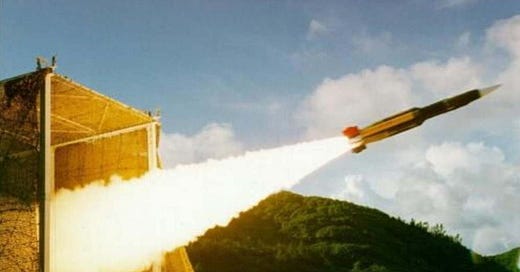By: Jens Kastner
Russia’s attack on Ukraine has profoundly rattled Taiwan, prompting the island to double down on the buildup of its own missile force. In a flurry of new defense-related developments that unfolded after the beginning of the invasion on February 24, a Taiwanese state-owned firm that develops indigenous weapons announced the test-firing of missiles in late March, with the details of the announcement hinting at long-range domestic missiles capable of hitting any Chinese gathering of troops and equipment before an invasion attempt against the island.
The National Chung Shan Institute of Science & Technology (NCSIST) warned aircraft and ships of an "unlimited" maximum projectile altitude, which would make little sense for the testing of medium-range missiles. Taiwan's defense ministry has also recently revealed that the institute’s 80 missile development and production facilities have been undergoing a major upgrade, more than doubling the annual output of Brave Wind III supersonic anti-ship missiles (above), Sky Sword II ship-launched/land-based missiles, and Sky Bow III Surface-to-Air Missile systems.
This indigenous output increase will complement the looming delivery of 300-km range Lockheed Martin Army Tactical Missile System (ATACMS) short-range ballistic missiles and 400 150-km range Boeing Harpoon anti-ship missiles that were ordered from the US last year.
Meanwhile, Taiwan’s military will take its clues from the success of Ukrainian forces’ use of portable missiles in dealing with Russian invaders heavy losses and include Javelins and Stingers in recruits’ basic training. Yet another noteworthy development since the Ukraine invasion began is that Taiwan finalized a deal with the US over a modern military communication system. Russian troops’ surprisingly weak performance is partly attributed to poor radio communications, with photographs showing Russian soldiers using cheap Chinese handheld radios and mobile phones without any military-grade encryption even during the most dangerous phases of combat.
“Taiwan’s development of long-range missiles, with procurement of a variety of missiles capable of hitting targets in either inner or coastal China across the Taiwan Strait, has been proceeding with a steady pace,” said Dr. Tzeng Yisuo, a research fellow at the Institute for National Defense and Security Research in Taipei.
“Taiwan thereby expands defensive space and enhances multidomain deterrence by developing and deploying standoff precision strike capabilities that disrupt enemy operational tempo and delay its advancement,” he said, “literally extending the range of operations to the coastal areas of mainland China to initiate source attack, thereby undermining or even annihilating adversarial forces before they head out.”
Tzeng explained that whereas Ukrainian forces have been using portable short-range anti-tank and surface-to-air missiles, Taiwan possesses missiles capable of striking at different ranges in multiple domains, while now also pursuing a buildup the deterrence-by-portable-missiles strategy and tactics.
Timothy R. Heath, a senior international defense researcher at the RAND Corporation, thinks that Taiwan’s decision to double production of its surface to air missiles and expand the inventory of other defensive weapons shows that the Russia-Ukraine war is reverberating around the world.
“Taiwan seems worried that China might be tempted to follow Russia’s example and launch an attack against the island,” Heath said. “The increase in missiles is a good move for Taiwan’s defense, as the missiles offer a good way to improve defenses by turning the anti-access, area-denial concept against the PLA.”
Professor Steve Tsang, Director of the University of London’s SOAS China Institute, for his part, cautioned that Taiwan’s priority must be anti-aircraft and anti-ship missiles rather than long-range ones, as the latter could reduce international support and sympathy in the event of war.
“Using Taiwan-based long-range missiles to attack mainland targets must be very carefully planned and implemented, as any civilian death on the Chinese mainland as a result would lose Taiwan some international sympathy or support, so the only legitimate target that Taiwan can strike on the mainland would be military installations and staging grounds for an assault on Taiwan,” Tsang said. “Taiwan will also need to train its forces to use foreign, mostly US-made missiles of these types, as Taiwan is likely to run out of their domestically produced missiles quickly in the event of a Chinese invasion.”
Taiwan, he said, “needs to have a contingency plan to ensure the manufacturing facilities in Taiwan can be put on a war-production footing very quickly and turn missiles out in large numbers very quickly because otherwise, they cannot resupply wartime usage.”
According to a new report by Sweden-based think tank SIPRI, Taiwan’s arms imports shrank by 68 percent between 2012–16 and 2017–21 but are scheduled to increase significantly in the coming years as China grows increasingly belligerent.'



